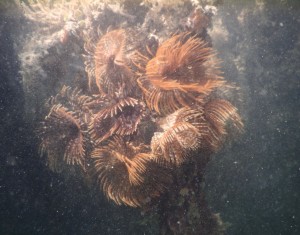Even on our way to the airport we managed to squeeze in one last snorkel. This time we went to the mangroves and swam around their roots, which many organisms use as a substrate to grow on. Fish also use mangroves as a nursery where they are fairly sheltered from larger predators. Upside-down jellies bobbed along the bottom of the sea bed and fire sponge glowed orange through the murky water.
I finally saw the magnificent feather duster, recognizable by its larger size and double crown of radioles. Their tubes were attached to the mangrove roots, among the encrusting algae, sponges and hydroids. They were various shades of brown and white and tucked their filter-feeding radioles into their tubes if you touched them. Unlike the other feather dusters I’ve seen, they didn’t tuck their radioles in all the way, and the tips of the crown poked out of the tube. I am guessing this is because they are too big to fit all the way in.
Time has never passed so quickly as it did on this trip. We were so busy and there was so much to do and see that the two weeks were over before I knew it. I was never bored for a second. Being back in Houston is so strange and claustrophobic. I already miss the fresh air and pristine nature. I’d take that over clean laundry any day!
Sophia Streeter
5/31









